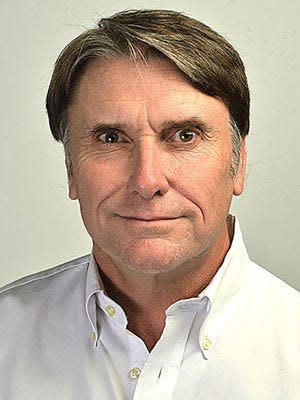Municipal Stadium housed baseball memories for a community
More than any other sport, baseball is built on memories. We dutifully record every last blessed pitch since the beginning of time, so we know, for example, that in 1928, Lefty Grove of the Philadelphia Athletics struck out three batters on nine pitches, a feat known as an immaculate inning. That rare accomplishment didn’t happen again until 1953.
So of course, baseball being baseball, news was made on Wednesday when a Houston Astros pitcher struck out Nathaniel Lowe, Ezequiel Duran and Brad Miller of the Texas Rangers on nine pitches in the second inning. That feat didn’t happen again until, well, the seventh inning, when a different Astros pitcher did the same thing, striking out — you guessed it — Nathaniel Lowe, Ezequiel Duran and Brad Miller. Stuff like that doesn’t happen in soccer.
So when readers were recently asked their favorite memory of 92-year-old Municipal Stadium, which was demolished this spring to make room for something or other, there were a lot to choose from, good and bad.
Municipal Stadium. Memories. It’s complicated.
I’ve written about my favorite memory before: President George Bush the elder was traveling through Western Maryland, with his son Neil, Chicago Bears legend Walter Payton, and Sports Illustrated writer Dan Jenkins as his guests. I think Bush had been staying at Camp David and playing golf in Frederick, and wanted to take in a little “local color” for the benefit of the cameras. He was a serious baseball fan, so his curiosity about the Hagerstown Suns may have been genuine.

A line of black Suburbans rolled into Municipal Stadium, and the president of the United States and his guests popped out. A guy in the bleachers happened to turn around and catch the unfolding scene in real time. Amazed, he tried not to spill his beer as he screamed to the fans, “Look everybody! It’s Walter Payton!”
But the stadium itself. Gee whiz. In one respect — OK, face it, a lot of respects — Municipal Stadium was the most homely, forgettable stadium on the planet. It didn’t so much seem like a real stadium as a collection of girders and block and aluminum pretending to be a stadium. The boxcars of lipstick that were slathered on that particular swine cannot be recounted.
And yet, Municipal Stadium was magic. Ugly, ugly magic. From Willie Mays to Bryce Harper, from Manny Alexander to Ryan Zimmerman, there always seemed to be someone on the field who was in some way interesting.
A team that at times had trouble attracting 700 fans drew 7,000 when Jim Palmer pitched. In 1989, pitching phenom Ben McDonald was perhaps the most hyped rookie in the history of the Orioles, and maybe all of baseball. We all came to watch his first game, expecting three or four immaculate innings at the least. Instead, we saw him give up his first grand slam as a professional.
The first time I saw Municipal Stadium was in 1981 when I was writing a story about the town rowdies who populated what was known as Section H. For nine innings this throng chanted, heckled, shouted, insulted and commented on anything that drew its attention.
So I remember them. I also remember the Marlboro Man in left field, a towering, cig-hawking cowboy who had to go when he was deemed to be an improper role model for the kids. He was not to be confused with the Dancing Cowboy who for a time changed the scoreboard and was frequently more entertaining than the game.
I remember the visiting players’ girlfriends who sat in the box seats and were identifiable by the swanky clothes and buckets of makeup they wore because — who knows?
I remember the sound the ball made when it struck the bat of Glen Davis, the Houston slugger for whom the Orioles traded away their future. He was a bust due to injuries, but my, what a swing.
I remember Bob Miller, Ears McNeal, William Blenckstone and the foul ball I caught — and the rotten luck I had of sitting next to a little kid I felt compelled to hand it to.
I remember the conversation between an 8-year-old boy and his dad when a streaker showed up:
“Why is he doing that?”
“Because he’s stupid.”
“Maybe it’s because he knows he has a big …”
“Shut up.”
I remember promotions, good and bad. The chili cookoff was a success, the Osama bin Laden bobblehead, not so much.
But maybe the most lasting memory of Municipal Stadium is the decades-long campaign to replace it. Community tax hawks balked at the $3 million a new stadium would have cost in the 1990s. Today a stadium is priced at some $60 million, so these financial watchdogs cost us $57 million. That’s ironic. That’s also baseball.
Tim Rowland is a Herald-Mail columnist.
This article originally appeared on The Herald-Mail: Hagerstown's Municipal Stadium ugly but memorable for its moments
